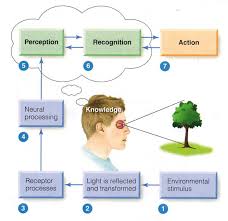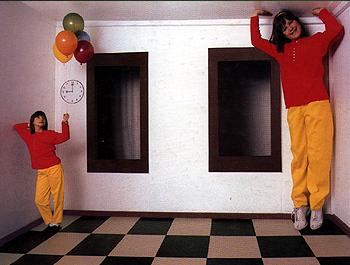MD Amin
Psychology - History and Systems
Professor Mark Berg
Journal Entry Chapter 14 - Perception
April 11th, 2020
After reading chapter 14, I was very much amazed at how complicated our sense of perception is and how it differs form person to person. This chapter started out talking about how there are still many unanswered questions about perception that are centuries old. We use visual perception everyday in our lives, for example crossing the street in traffic, slowing down or speeding up when the light turns yellow, and solving equations with patterns and objects. The process of perception works with our eyes and mind working together. We first see an object in the environment and then the light hit in our retina and gives us the color, shape, and or form of the object. The signal then goes to our brain of what the object may be. From there whatever we perceive that object is, that is what the brain process and excepts. For example if we see a bright blue car, then in our retinas the color blue will come up, and we will see a shape of a car, this information will go to the brain and the brain will accept the image as a bright blue car.

However, where there are more details, shapes and patterns, we will see that which we choose to see. This is especially true for optical illusions, there will be two images, but we will only see one image.
For example in the image below you can either see a young beautiful lady or and old lady, it depends on what you want to see. Very similarly in the second image you can either see an old couple or you can see a man with a guitar and another man with a turban.


Sometimes we cannot see color, so we have to rely on understand shapes and images, for example walking home at night in the dark. We would have to rely on shapes and shadows to find our way safely, however sometimes we fail to understand the shapes. We also use movement and depth to understand perception as well. We use size, location, and object angle to understand how fast something is moving. For example we use our binocular vision to perceive how big an object is and how far it is from us. For example this allows us to get out of the way of danger if a car or any other threat was coming in our way. We also use depth perception to understand how tall or short someone is. We can tell how far away a person is by speculating the environment around that person. The further a person is the small her or she will look and the bigger the objects around them will look. However the closer they are, the bigger the person will look and the object around them will look smaller. Nonetheless, there was an invention known as the "Ames Room" by the American scientist Adelbert Ames Jr. in 1946. This invention created an optical illusion based on depth, where the room had an uneven ceiling and floor.

Lastly, there are two ways to look at vision, one way is the neutral approach and the other way is the cognitive approach
The Neutral Approach - This is more of a biological approach where the process begins in the retina and rods become more sensitive to low levels of illuminations or more intense levels, the cones responds to visible light, special shapes, and motion. Then from the rods and cones the message is delivered to the brain.
The Cognitive Approach - This is a more mental process, this process deals with feature identification from recognition, cue-derived depth perception, and recognition of figures when much of the information is missing.
Overall the author did very good job at explaining the different techniques we subconsciously use to perceive all the things we see or think that we saw or missed seeing everyday. .

Point of view - My point of view on perception is that I think it is more of a cognitive approach then a neutral approach. I say this because everybody sees everything differently, what someone might find attractive others might not.
Information - In addition, some people might miss seeing something in a picture or a video that others might catch onto. Usually whenever we are looking hard to find something we usually find it. However if we not looking for something in a picture or even in everyday life, then we will not find it.
Conclusion - In conclusion I will say that no matter what we are given to perceive, we choose to see things the way we ourselves choose to see. In other words, we choose to see what we want to see, and that often times is a reflection of our emotions, feeling, and I think our cognitive thinking.
Psychology - History and Systems
Professor Mark Berg
Journal Entry Chapter 14 - Perception
April 11th, 2020
After reading chapter 14, I was very much amazed at how complicated our sense of perception is and how it differs form person to person. This chapter started out talking about how there are still many unanswered questions about perception that are centuries old. We use visual perception everyday in our lives, for example crossing the street in traffic, slowing down or speeding up when the light turns yellow, and solving equations with patterns and objects. The process of perception works with our eyes and mind working together. We first see an object in the environment and then the light hit in our retina and gives us the color, shape, and or form of the object. The signal then goes to our brain of what the object may be. From there whatever we perceive that object is, that is what the brain process and excepts. For example if we see a bright blue car, then in our retinas the color blue will come up, and we will see a shape of a car, this information will go to the brain and the brain will accept the image as a bright blue car.
However, where there are more details, shapes and patterns, we will see that which we choose to see. This is especially true for optical illusions, there will be two images, but we will only see one image.
For example in the image below you can either see a young beautiful lady or and old lady, it depends on what you want to see. Very similarly in the second image you can either see an old couple or you can see a man with a guitar and another man with a turban.

Sometimes we cannot see color, so we have to rely on understand shapes and images, for example walking home at night in the dark. We would have to rely on shapes and shadows to find our way safely, however sometimes we fail to understand the shapes. We also use movement and depth to understand perception as well. We use size, location, and object angle to understand how fast something is moving. For example we use our binocular vision to perceive how big an object is and how far it is from us. For example this allows us to get out of the way of danger if a car or any other threat was coming in our way. We also use depth perception to understand how tall or short someone is. We can tell how far away a person is by speculating the environment around that person. The further a person is the small her or she will look and the bigger the objects around them will look. However the closer they are, the bigger the person will look and the object around them will look smaller. Nonetheless, there was an invention known as the "Ames Room" by the American scientist Adelbert Ames Jr. in 1946. This invention created an optical illusion based on depth, where the room had an uneven ceiling and floor.

Lastly, there are two ways to look at vision, one way is the neutral approach and the other way is the cognitive approach
The Neutral Approach - This is more of a biological approach where the process begins in the retina and rods become more sensitive to low levels of illuminations or more intense levels, the cones responds to visible light, special shapes, and motion. Then from the rods and cones the message is delivered to the brain.
The Cognitive Approach - This is a more mental process, this process deals with feature identification from recognition, cue-derived depth perception, and recognition of figures when much of the information is missing.
Overall the author did very good job at explaining the different techniques we subconsciously use to perceive all the things we see or think that we saw or missed seeing everyday. .

Point of view - My point of view on perception is that I think it is more of a cognitive approach then a neutral approach. I say this because everybody sees everything differently, what someone might find attractive others might not.
Information - In addition, some people might miss seeing something in a picture or a video that others might catch onto. Usually whenever we are looking hard to find something we usually find it. However if we not looking for something in a picture or even in everyday life, then we will not find it.
Conclusion - In conclusion I will say that no matter what we are given to perceive, we choose to see things the way we ourselves choose to see. In other words, we choose to see what we want to see, and that often times is a reflection of our emotions, feeling, and I think our cognitive thinking.
Comments
Post a Comment